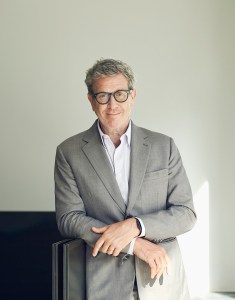The international art market ramps up this month with a slew of major auctions in Hong Kong, London and Paris, including the sale of the contents of the Hôtel Lambert in Paris amassed by the Qatari royal family, and the collection of US billionaire Gordon Getty and his late wife Ann in New York. Fairs include Frieze London and Frieze Masters and the new Paris+ par Art Basel in Paris. But the global economic outlook is worsening.
On the 26th September, the Organisation for Economic Co-operation and Development (OECD) downgraded its economic forecasts for the UK, the Eurozone, Japan, the United States and China. All this is creating jitters for auction houses, galleries and the artists who depend on them. Accompanying a full analysis published in the October issue of Apollo, Jane Morris asks six leading economists and art advisers for their views on the prospects for the art market over the next few months.
Paul Donovan
We are in a very strange place in the global economy. We’ve had the extraordinary event of the pandemic and the response to it, while we’re going through the fourth industrial revolution – automation, robotics, digitisation, the internet of things – which is the biggest structural change in the economy in 250 years. We have the lowest unemployment rates in 40 years but at the same time the most negative real income growth, in the case of the United States, since records began in the 1950s. It is making it difficult for economists to predict whether different regions will suffer a slowdown, a slump or a really severe recession. That uncertainty is likely to continue into the first part of 2023 and then things should stabilise.
The art market has traditionally been classified with luxury goods. For ultra-high-net-worth people, art has an extraordinary brand value just as, say, Gucci does. There’s also an element of the art market that’s akin to the high-end travel industry because it is very experience-focused – going to the art fairs, meeting people. But we have also had considerable volatility in financial markets and real estate. The wealthy have certainly been affected, reflecting the general economic situation, although not as much as people lower down the income scale. After the pandemic, no matter what your income, the attitude was, ‘After the past two years, we deserve to treat ourselves.’ And if you’re somebody who is passionate about art, art is going to be how you do that. But there’s going to be some moderation: it was one thing to say ‘we deserve it’ in 2022, it’s a bit harder to keep that going into 2023.
Paul Donovan is global chief economist of the Swiss financial services firm UBS Wealth Management.
Ben Clark
While there are diverse pools of buyers throughout Europe and Asia, the biggest market for art remains the United States: it has by far the biggest influence on the art market at every level, so a lot depends on what happens there. Even if sophisticated collectors at the upper echelons of the market aren’t badly affected, confidence remains a major concern. Half the art market – the primary galleries and the big auction houses — are market-makers and platforms. Confidence is very important for them, as a marketeer building confidence [around your product] is your job.
In any downturn, art under $200,000 tends to be the level that’s most affected, and that’s where the majority of transactions take place. Collectors at this level are more often passionate about the art and artists: it remains a luxury or a discretionary spend for them. Art in the tier above $10m tends to mostly hold its own, the artwork that appears in the evening sales at the major auction houses. These are artworks with a proven price performance, liquidity and international appeal.
These sales also tend to get the headlines and can give an overall impression of market health, even if they only represent a fraction of the market and a small pool of buyers. It’s worth remembering that even the top end doesn’t always hold, especially if you pay too much. Think about the bubble in Post-Impressionism and École de Paris artists caused in the late 1980s by Japanese buyers; 30 years on, prices for some of those works still haven’t recovered.
Ben Clark is chief executive of art advisory group Gurr Johns.
Canice Prendergast

Canice Prendergast
Looking over the past 20 years, there are two really notable things about the art market. The first is it doesn’t really respond to the economy that much anymore — it responds to inequality. There is no market that I can think of that has benefited from the rise in ultra-high-level wealth quite like the art market has. It’s extraordinary the extent to which prices for art essentially track how high-income people are doing. The pandemic exacerbated that. Small companies, like your typical restaurant, got crucified. Big companies did great — and the art market did great because the wealth of the very wealthy tends to be tied to larger companies.
The second thing is that art is different to yachts, for example, in that is art is not just something to be consumed, it’s also an asset. Even in circumstances where the stock market starts to tank, people will think, ‘Hey, maybe I’ll buy a painting.’ Contemporary art has finally become a globalised status commodity in a way that it never has been before and that’s making it very hard to work out whether the recession is going to have any effect at all.
Canice Prendergast is the W. Allen Wallis Distinguished Service Professor of Economics at the University of Chicago Booth School of Business.
Sibylle Rochat. Photo: Kate Martin

Sibylle Rochat
There are two kinds of people in the art market at the moment. There are people who see art as a luxury who probably won’t be buying if there is a bad recession. Then there are those who are cash rich, who see art as an investment and a hedge against inflation. These include people who spend $10m and above – the tiny percentage of people who normally get richer in a crisis. There will also be some people who aren’t in this bracket who will be forced to sell trophy work that was sitting in their family for years. This will mean amazing work coming on to the market with all the promotion that comes from the auction houses and the press, which will feed the high end of the market.
Buying will also remain strong for the young artists who are attracting all the current speculation. It’s like a wild horse out of the stable, it’s a way for collectors who can’t afford the trophy work to get involved with something super-exclusive and difficult to get and to play the game.
The market that will be most affected are the artists in the middle, people with a good track record and institutional history but there’s still inventory at the gallery. Despite that, the art market is changing a lot. It used to be that only a very small part of the population was buying art, but new buyers are coming in the market every day. It’s harder to predict their taste and how the future generations will consume art, but it means that even though we are in for a tough time, it is nothing like as hard as it might have been.
Sibylle Rochat is the founder of art advisory Rochat Art Consultancy, London.
Paul Hewitt

Paul Hewitt
London galleries had a good run in to the lead up to the autumn, although some collectors have clearly been hoping for a bargain, so sales have gone through with more negotiation: who’s paying transport? Who’s paying artist’s resale rights? Who’s paying storage? Auction houses and dealers are generally de-risking at the high end, involving third party financing [in top works] where they can.
The pandemic has been good training, ironically, with a lot more galleries aware of the importance of managing overheads. The main concern is the ‘feel-good factor’. When that goes, the contemporary market in particular tends to suffer. But it is usually temporary. I believe the core is solid, but at the edges it could become a little bit more ragged. A lot is riding on events such as Frieze in London next month, and the big auctions in London and New York in November.
Paul Hewitt is the director general of the Society of London Art Dealers (SLAD).
Marc Glimcher. Photo: Suzie Howell

Marc Glimcher
A bad recession affects everybody. We have a challenging two years coming up, which will be tough for some people in the art world, for sure. But hard times are usually a great crucible for new art. And we do have this strange phenomenon in the art world: we rise in a boom, but in difficult times art can also be a hedge.
The important thing to remember is that the art world is still growing. When my father founded the Pace Gallery in 1960, he will tell you there were about 25 American contemporary art collectors. Now Pace has over a million Instagram followers and 5,000 clients. The visual arts are proliferating and that has a lot to do with the ways society is changing. What people have to realise is we are the tiniest branch of the arts economy: music, film and dance are huge, mature industries. We have nothing but blue sky ahead of us in terms of our ability to impact millions of people.
Marc Glimcher is the president and chief executive of Pace Gallery, which has eight galleries in the US, UK, continental Europa and Asia.



